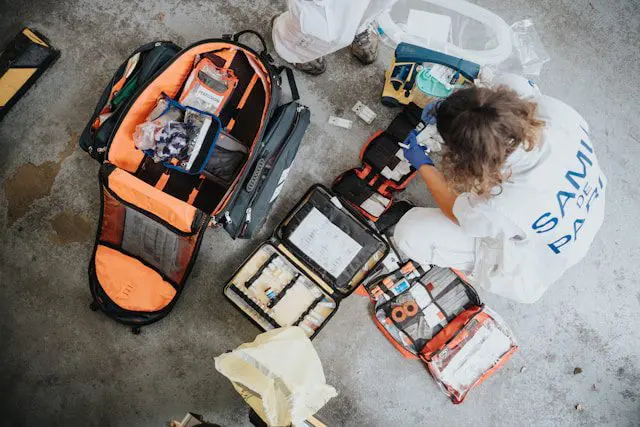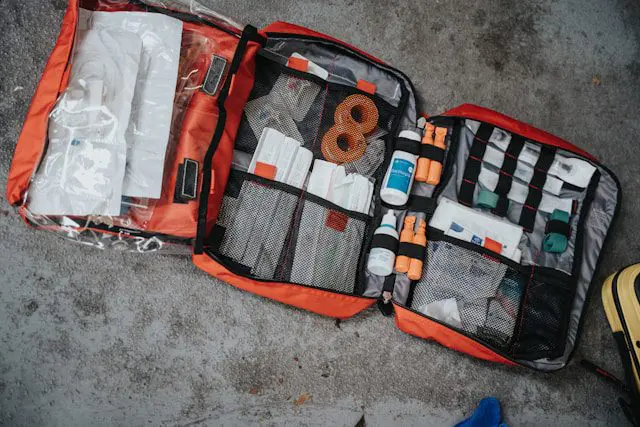In the face of an unexpected disaster, being prepared can mean the difference between life and death. In fact, unintentional injury is the leading cause of death in the U.S. for individuals under 44. A robust first aid kit serves as your first line of defense and ensures you can handle emergencies with confidence. This guide focuses on helping you choose the best first aid kit for survival, designed to provide essential medical support in the most critical situations.

What Makes the Best First Aid Kit for Survival? | Our Top Picks | Your DIY First Aid Kit | Safety Tips | FAQs | Additional Resources | Wrapping Up
What Makes the Best First Aid Kit for Survival?
A top survival first aid kit isn’t just packed with supplies—it’s a beacon of safety in unpredictable environments. Here’s what you need to ensure your kit is up to the challenge:
- Wound Care: Various sizes of bandages, gauze pads, antiseptic wipes, antibiotic ointment, and burn cream are crucial.
- Tools: Additionally, items like tweezers, scissors, medical tape, and safety pins can make all the difference in managing injuries.
- Medications: Include essential meds such as pain relievers, antihistamines, and antacids.
- Other Essentials: A CPR mask, instant cold pack, gloves, and a reliable first aid manual are indispensable.
Our Top Picks for the Best First Aid Kit for Survival
MyMedic MyFAK First Aid Kit: Best Comprehensive Kit for Adventurers
The MyMedic MyFAK kit is a versatile and comprehensive option suitable for both intense outdoor adventures and everyday use. It includes a wide range of medical supplies from basic bandages and gauze to more specialized equipment like tourniquets and pressure dressings. Its rugged design features a durable, water-resistant outer bag and modular compartments for easy organization and quick access.
Surviveware Comprehensive Premium First Aid Kit: Best for Quick Access
Surviveware’s Comprehensive Premium First Aid Kit is designed for efficiency and quick access, with well-labeled compartments that facilitate easy identification and retrieval of items under stress. It is also waterproof, making it suitable for all weather conditions. This comprehensive kit includes a variety of bandages, tools, and survival items like a multitool and an emergency whistle, which makes it ideal for serious outdoor enthusiasts.
Adventure Medical Kits – Mountain Series Explorer: Best for Group Trips
The Mountain Series Explorer kit from Adventure Medical Kits is tailored for small groups, supporting up to four people on multi-day trips. It includes medical supplies proportionate to group size and trip duration, featuring items like wound irrigation systems to clean injuries and a manual for dealing with common outdoor health issues. Its organized contents and clear instructions make the kit user-friendly, even for those with limited medical knowledge.
Rescue Essentials IFAK First Aid Kit: Best for Rapid Response
Designed for rapid response in critical situations, the Rescue Essentials IFAK contains high-grade, professional medical tools in a compact, easy-to-carry package. This kit focuses on severe trauma management with items like chest seals for treating penetrating chest injuries and a Nasopharyngeal airway with lubricant. First responders and professionals favor this kit for its focus on critical care components.
Swiss Safe 200-Piece Professional First Aid Kit: Best Dual Kit System
The Swiss Safe 200-Piece Professional First Aid Kit offers a dual-kit system, including a full-sized main kit for home or base camp and a smaller, portable kit for excursions or travel. The main kit covers a broad spectrum of medical needs with over 200 essential supplies, making it exceptionally versatile for families or groups. The smaller kit is perfect for individual use, ensuring readiness on-the-go without the bulk.
Everlit Survival First Aid Kit: Designed by U.S. Military Veterans
U.S. military veterans designed the Everlit Survival Kit, integrating both comprehensive medical supplies and survival tools into one compact system. This kit includes tactical survival tools like a paracord bracelet, a flashlight, and a fire starter, alongside a full suite of medical supplies tailored for handling common injuries and emergencies in rugged environments.
I Go Compact First Aid Kit: Best Budget-Friendly Compact Kit
The I Go Compact First Aid Kit is ideal for personal use during outdoor activities like hiking and cycling. Despite its small size, it is packed with essential supplies necessary to handle common injuries, such as cuts, scrapes, and minor burns. The compact design allows it to fit easily into a backpack or glove compartment, making it perfect for individuals looking to stay prepared without carrying a lot of weight.
DeftGet First Aid Kit: Most Durable
Experts recognize the DeftGet First Aid Kit for its durability and comprehensive coverage. With 163 medical items, it includes everything from bandages and dressings to tools like tweezers and scissors, all housed in a hard-wearing case that resists damage from falls and impacts. This kit provides reliable service over time, making it a great choice for family homes, cars, and camping.
Your DIY First Aid Kit: Customization and Considerations

Besides purchasing ready-made options, building your own first aid kit offers a tailored approach to preparedness, allowing you to customize contents specifically suited to your lifestyle and needs. Here’s why you might consider going the DIY route and what to keep in mind:
Pros of Building Your Own Kit:
- Customization: One major advantage is customization; specifically, you can tailor your kit to match your specific health requirements and activities. This ensures you have everything you might need in an emergency, without any unnecessary extras.
- Cost-Effectiveness: Often, assembling your own kit can be more economical. You can purchase supplies in bulk and avoid paying for pre-assembled kits that might include items you don’t need.
Cons of a DIY First Aid Kit:
- Time Investment: Finding and purchasing each item individually requires more time compared to buying a pre-packed kit.
- Maintenance: You must be vigilant about monitoring and replacing expired or used items to maintain the kit’s readiness.
Important Considerations:
- Regular Checks: It’s crucial to routinely check and replenish your kit, especially after any use or as products near their expiration dates.
- Adaptability: Your kit should evolve as your activities or health conditions change. Regular reviews of the contents will help you stay prepared for new challenges.
The Red Cross has a comprehensive checklist of items to include in a first aid kit for survival on their website if you decide to go the DIY route.
Safety Tips for Using Your First Aid Kit
Master Your Kit
Each item in your first aid kit has a specific purpose, from staunching blood to preventing infection. Take time to understand not just what each item is, but when and how it should be used. For instance, know the difference between using butterfly bandages for small lacerations and when to apply pressure dressings for more severe bleeding.
Routine Inspections
Just as you would check the oil in your car or the batteries in your smoke detector, your first aid kit requires regular inspection. Mark your calendar to review the kit every three months. Check not only for expired items but also for supplies that may have been used and need replenishing or items that may have become damaged, such as cracked cold packs or dried-out antiseptic wipes.
Hands-On Practice
Reading instructions is a start, but nothing beats hands-on practice. If your first aid skills are rusty, the American Red Cross offers first aid training online to get you up to speed. These courses cover everything from basic first aid to CPR and emergency response techniques.
Organize quarterly family safety drills where you practice scenarios like applying a splint or dressing a wound. This ensures that in a high-stress situation, your memory muscle kicks in.
These tips will help you maintain a first aid kit for survival that is not only well-stocked but also a powerful tool in your hands, ready to deal with emergencies effectively.

FAQs about First Aid Kits for Survival
How often should I update my first aid kit?
Check your kit at least once every six months and replace expired or used items.
What are the most commonly overlooked items that should be included in a first aid kit?
While most people remember to include bandages and antiseptic wipes, there are several overlooked items that can be crucial in emergencies. For instance, a digital thermometer can help monitor potential infections or illnesses. Similarly, a small notepad and pencil can be invaluable for recording vital signs and symptoms before professional help arrives, which is critical during an emergency. Additionally, including emergency blankets and hydrocortisone cream can assist in managing shock and mild allergic reactions, respectively.
Can a first aid kit expire?
While the kit itself doesn’t expire, individual components, especially medications and sterile items, can expire and should be regularly checked.
Additional Resources
- American Red Cross First Aid App: Offers step-by-step instructions for everyday first aid scenarios and can help keep your skills fresh.
- CDC Emergency Preparedness: Provides comprehensive guidelines on how to prepare for emergencies, including what to stock in your first aid kit.
- FARE (Food Allergy Research & Education): Useful for those needing to add specific medical supplies related to allergies.
- If needed, make sure to pack allergy-friendly foods in your pack in addition to first aid. See our guide to the best nut-free protein bars for a nutritious calorie boost in an survival situation.
Wrapping Up: Stay Safe and Prepared
Ultimately, investing in the best first aid kit for survival equips you with the tools and supplies needed to handle emergencies confidently, thus ensuring your adventures are safe and enjoyable. Next, check out our guide on the only camping packing list you will ever need to help round out your survival skills.
What essential items do you always include in your first aid kit for camping trips? Share your experiences in the comments below!


Leave a Reply